386 Search Results for complex communication
October 19, 2015
by Carole Zangari -
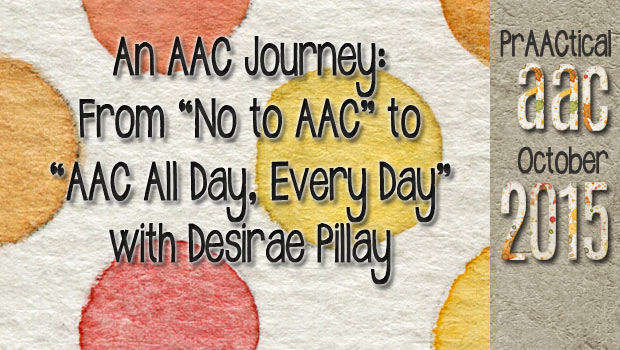
What better way to celebrate AAC Awareness Month than to share AAC stories from around the world? In this post, we welcome Desirae Pillay, who shares a bit about her daughter, Savannah, and their AAC journey. As the mother of a young adult with ASD and cerebral palsy, Desirae has taken what she has learned about AAC and is using it to help others outside of her family. Desirae began her journey with AAC in 2003 when she could not find a qualified AAC specialist to assist her with her daughter. Her experience and informal learning gained her a job for an AT company. When her daughter’s health needs became pressing, she resigned her job and worked part time as a Disability Consultant for various organisations. Desirae recently returned to work as an AT Advisor, where she trains on a range of topics about communication for people with disabilities. Her passion is for... [Read More...]
September 21, 2015
by Carole Zangari -
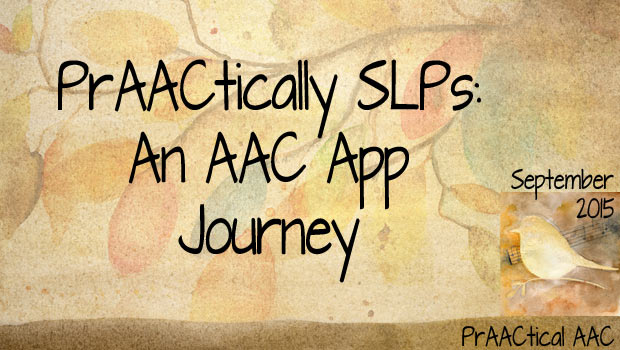
What is more amazing than seeing kids with AAC needs become competent communicators? How about seeing the next generation of SLPs become competent in AAC?! It is over-the-moon exciting to think of how many lives we could touch if more SLP students became passionate about AAC. Today, we add to our series called PrAACtically SLPs, where we hand the reins to students studying to be SLPs who’ve taken a special interest in AAC. This post is authored by Stephanie Johnson and her colleague Brianna Simmons, two Australian student Speech Pathologists from Macquarie University. They recently completed a clinical placement at Lifestart, an agency that supports children and young people living with disability. Because many of the children on their caseloads had significant communication challenges, AAC options became an important focus of their intervention. In this post, they tell us about their journey learning to use an AAC app with some of their clients. Please... [Read More...]
July 14, 2015
by Carole Zangari -
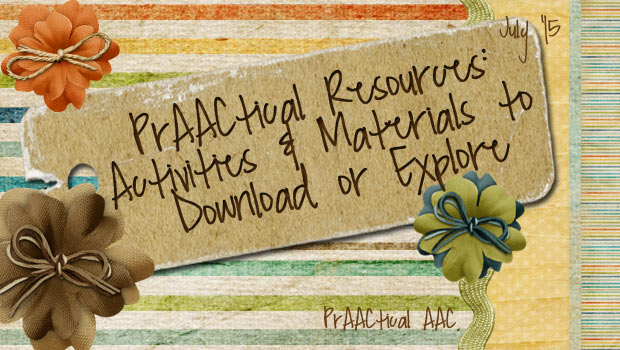
The great thing about getting stuck at an airport these days is that almost all of them have free internet connections. Some people surf the web for celebrity news, fashion tips, or recipes. AAC people, on the other hand, never miss an opportunity to search out interesting tools and resources. Here are a few from my latest airport adventure. Communication Games and Activities from AAC Scotland: Lots of fun and prAACtical ideas, like the Roving Reporter activity. Graphic Organizers with Teaching Notes: Graphic organizers are some of my favorite tools, but it takes time to convert the paper-based ones to interactive PDFs that our AAC learners can use. When I found this site from Holt McDougal (part of Houghton Mifflin), I squealed with joy. It’s a real time-saver! Story Visualizer: This website from the Education Team at Lego is a great way to motivate kids to communicate and build narratives.... [Read More...]
June 15, 2015
by Carole Zangari -

Although summer is just beginning, many SLPs in our region are already thinking about the next school year. If you are trying to increase classroom use of AAC, you will want to check out the core vocabulary resources developed by Tabi Jones-Wohleber. Tabi is a Maryland-based SLP who works on the Frederick County Public Schools AT Team. You can view her earlier post (and accompanying downloads) here. In this post, Tabi shares her wonderful Communication Opportunities Ready to Engineer (CORE) book and explains how she uses these materials. ::::::::::::::::::::::::::::::::::::::::::::::::::::::::::::::::::::::::::::::::: Classroom CORE (Communication Opportunities Ready to Engineer) Book: When posed with the question “How can I use core more?” by a group of teachers inspired to make communication a priority, I was thrilled to be part of a team motivated to investigate this exciting question. These talented Rock Creek School educators teach a diverse population of students with all manner of physical,... [Read More...]
April 8, 2015
by Carole Zangari -
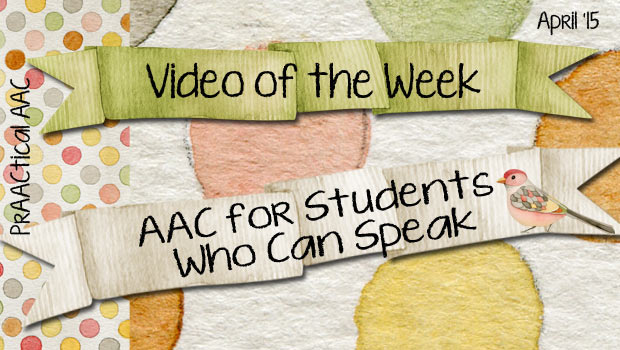
“But my student can speak. Why would we use AAC?” We often get this question from our fellow SLPs, particularly those who work with students who have autism. From the question alone, it seems like AAC is not needed, and would be a step backward for this particular student. But what happens when we dig a little deeper? The last time this question was posed to me, it was about Marcella, an 8 year old with ASD. As the conversation progressed, we learned more about Marcella’s communication profile. Independently, she uses 2-3 word sentences to ask for things she wants (e.g., “Want that popsicle.” “More Dora”) and single words to protest (“No!”). With prompting Marcella uses 1-2 words for greeting (e.g., “Hi Tony”), labelling (e.g., “Dora book”), answer questions, (e.g., “here,” “sunny”) and a few other social purposes. So, what’s the problem? For starters, Marcella is capable of more. In... [Read More...]
February 12, 2015
by Carole Zangari -

Those of you who are still digging your way out of the most recent snowstorm may not believe it, but it’s almost time to make plans for summer. There are quite a few AAC camps, some that are quite well established and others that have been running for only a few years (see our AAC Camp Pinterest board here). In this post, we hear about one of them from Tina Moreno, an SLP and mom of Mateo, who uses PicturePower 100 on the Maestro to communicate, maintain friendships with his teammates on the cross country team, advocate for himself, reveal his wicked sense of humor, and even sing the National Anthem for his high school’s basketball games. Tina blogs at Voices4All. With the help of Drs. Karen Erickson and David Koppenhaver, she and her friend Gina Cunningham created Camp ALEC together in memory of Gina’s son Alec, who never gave up, and... [Read More...]
October 30, 2014
by Carole Zangari -
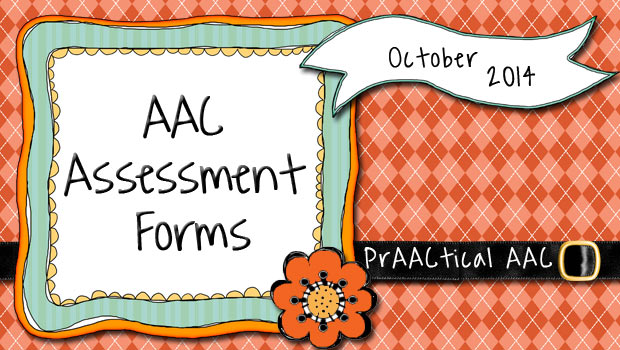
One of the challenging things about teaching graduate student SLPs to do AAC assessments is that there is no single, comprehensive protocol to cover the needs of all types of clients. We’ve started a collection of forms and thought some of you might find them helpful. If you know of others, please get in touch so we can add to the list. That way we’ll have them all in one place. Intake and General AAC Assessment AAC Assessment Protocol: Gail Van Tatenhove AAC Checklist and Rubric: Tufte AAC Intervention Rubric: Angela Standridge, Texas Region 4 Education Service Center Adult Pre-Assessment (Acquired Disabilities): Gail Van Tatenhove Adult Pre-Assessment (Congenital Disabilities): Gail Van Tatenhove Bloom and Lahey-Early Communicative Forms and Functions: Exceptional Children Division, NC Department of Public Instruction Dynamic Assistive Technology Evaluation (DATE) Collaborative Worksheet: Texas AT Network Needs Assessment: Gail Van Tatenhove Pediatric Pre-Assessment: Gail Van Tatenhove Picture Assessment: Gail... [Read More...]
October 16, 2014
by Carole Zangari -
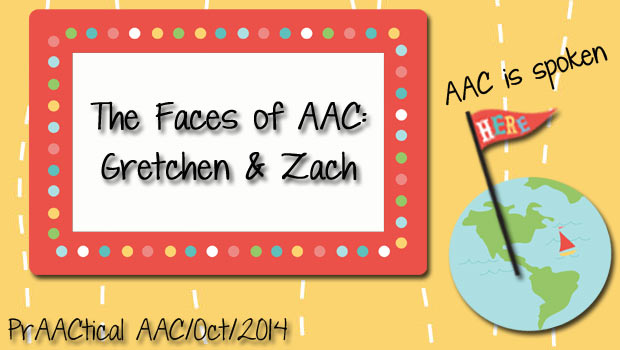
From Bielsko, Poland, to Denver, USA, we are continuing to share the Faces of AAC. Today, we meet SLP Gretchen Storm, who works in the public school system and has a private practice. Gretchen enjoys collaborating with parents, children, teachers, other healthcare providers, siblings and peers in strategies and facilitating communication through speech generating devices. In this post, Gretchen introduces us to Zach. :::::::::::::::::::::::::::::::::::::::::::::::::::::::::: Zach is an 11 year old who uses a Tobii I-12 eye gaze communication device to communicate. He previously used a switch scanning method on a VMax from Dynavox. Zach recently switched to an eye gaze device. Though he loves to use his arms and hands whenever possible, his motor control of them is not ideal for the consistent switch access needed for switch scanning. He was switched to an eye gaze system which could also serve as a switch scanning device if in the future he demonstrates improved... [Read More...]
October 9, 2014
by Carole Zangari -
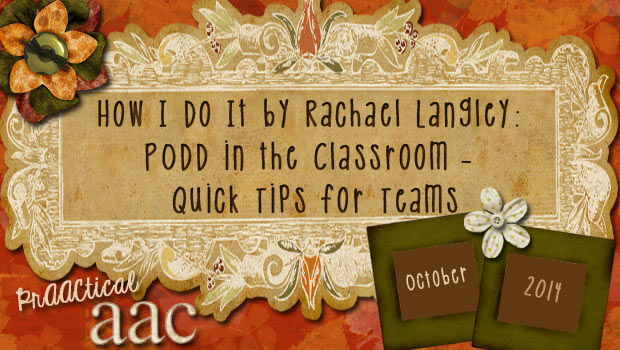
Today we welcome SLP Rachael Langley, who has been working in the public schools as a speech-language pathologist for over 12 years. Currently working as an AAC Specialist in Mid-Michigan, Rachael tells us that she strives to spread the message about the importance of AAC and unlocking the communication potential of all students. In this post, Rachael shares some of her best tips for building communication with learners who are getting started with PODD books. The PODD system offers a complete language approach through carefully organized symbol sets. Because the PODD system promotes a language immersion model, there is no pressure on our language-learners reproducing specific words or patterns at a specific rate. Here are some quick tips I share with classroom teams who are starting out with PODD: Input before output! Model, model, model! – Without digging too deep into the importance of Aided Language Stimulation, we want to make sure... [Read More...]
September 8, 2014
by Carole Zangari -
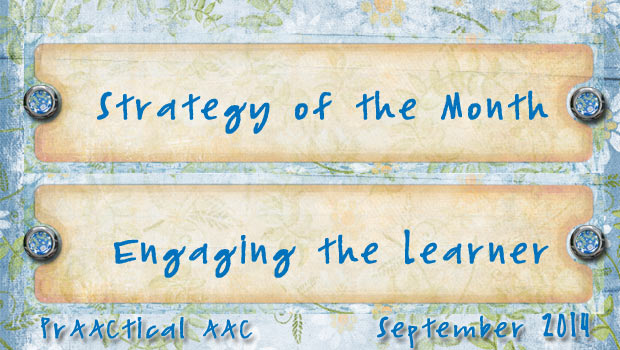
Summer is over in our part of the world and that means we get the opportunity to work with a whole new crop of students and clients. There is so much for beginning clinicians to know about providing AAC services that it is intimidating at best and overwhelming in most cases. In previous posts we’ve written about expectations, goal-setting, intervention strategies, therapy activities, reinforcement, feedback, and the like. This month, we’ll focus on a construct that permeates everything: engagement We all know what it looks and feels like when a client is engaged, but how do we make that happen? Here are some thoughts. 1. Start by presuming that your client is a learner on his/her way to developing competence. Good intervention, consistent language models, the right tools, and plenty of practice will move them along the journey toward improved communication. It’s important that, as clinicians, we truly believe that.... [Read More...]









